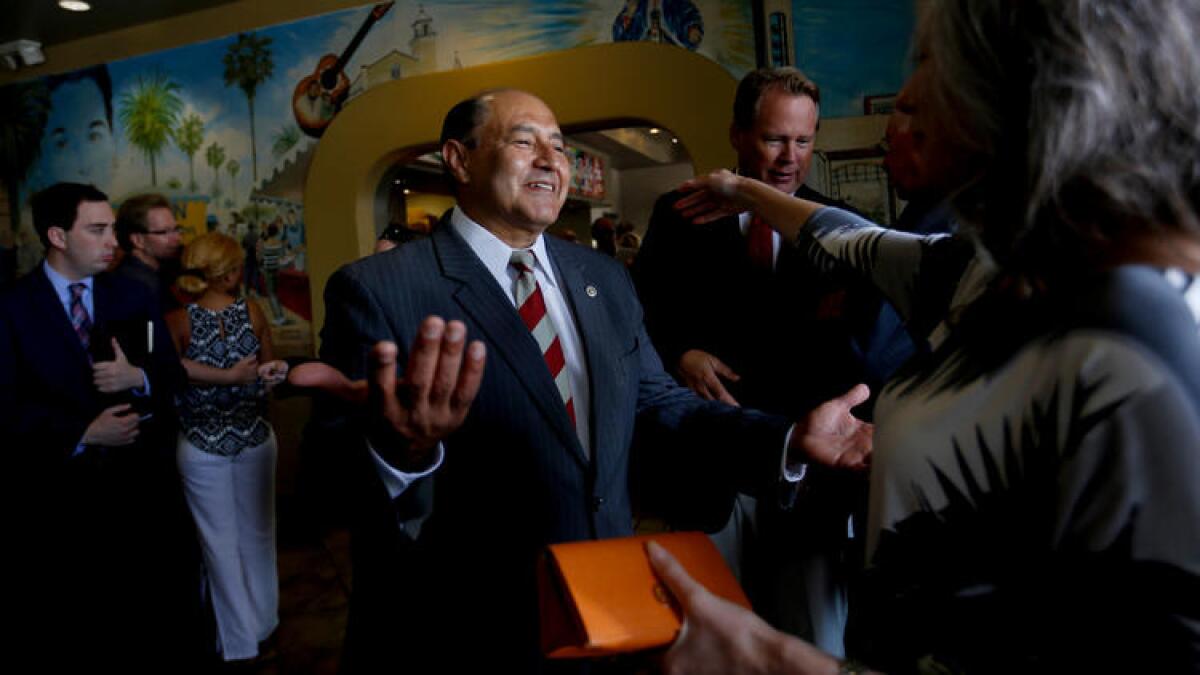Orange County hasn’t had a Latino supervisor in more than a decade. Will redistricting change that?

- Share via
Nearly a third of Orange County residents are Latino, but the powerful Board of Supervisors has not had a Latino member in 15 years.
One reason is the way the district boundaries have been drawn. An east-west line divides Santa Ana and heavily Latino sections of Anaheim into two different districts.
On Tuesday, the board is expected to approve a majority Latino district for the first time, in a once-in-a-decade redistricting process following the national census.
The board has whittled down the options to three proposed maps, all of which create a majority Latino district as well as a district encompassing many Asian American voters.
Orange County hasn’t been majority white in nearly 20 years and has become increasingly politically diverse. The county, once a bastion of conservatism, has turned purple, voting against Donald Trump twice and against the recall of Gov. Gavin Newsom in September. Its population is 38% white, 34% Latino and 22% Asian.
But, as is often the case, political power for growing ethnic groups has lagged behind their demographic strength.
Unlike in Los Angeles County, which has delegated this year’s redistricting to an independent commission, the Orange County supervisors themselves will have the final say. The board, which has two Asian American and three white members, has been majority Republican for years.
For Latinos grappling with rising housing and healthcare costs, overcrowding, homelessness and a pandemic that disproportionately affected them, the outcome will have major ramifications.
While a majority Latino district appears to be a certainty for the first time, the three maps vary in how much they concentrate Latinos in a second district and how much power they give to Asians. Supervisors have also proposed tweaks to the maps under consideration.
“They have been able to keep districts that largely return a very solidly conservative Board of Supervisors, despite the county becoming way more purple, if not purple with a blue tint to it,” Matthew Jarvis, an associate professor of political science at Cal State Fullerton, said of the board. “I think that population growth being what it is, they may be able to draw the lines for the supervisors’ districts in such a way to keep that stranglehold on.”
District lines are not the only barriers for candidates who are trying to appeal to Latino voters.
Latinos who are immigrants can be sidelined by language barriers and a shortage of local political coverage in the Spanish-language media.
By contrast, Asian American communities in Orange County, especially in Little Saigon, are politically engaged and turn out to vote at higher rates than Latinos, advocates say.
But “cracking” — dividing adjacent cities with ethnic majorities, as happened with Latinos in Santa Ana and Anaheim — has been a major factor, said Sonja Diaz, a civil rights attorney and founding director of the UCLA Latino Policy and Politics Initiative.
“Orange County has for far too long been dictated by the policy preferences of an aging, white electorate that leans conservative,” Diaz said. “And I say this as a jurisdiction that is increasingly multiethnic and multiracial, with large communities of Asian American and Latino electorates.”
The federal Voting Rights Act requires that boundaries be drawn to give areas with a high percentage of people of color a chance of electing a representative from their community.
“I mean, 34% of our population in Orange County is Latino, so one has to wonder why isn’t there a voice for the Latino community represented on the dais,” said Supervisor Katrina Foley, a Democrat whose District 2 includes Huntington Beach and other coastal communities.
One proposal being considered by the board would create a district that has nearly 54% Latinos of voting age, including portions of Anaheim, Garden Grove, Orange and Santa Ana.
The proposal also creates a district with about 37% Asian voters, while spreading out the remaining Latino voters, prompting some criticism that it dilutes Latino power.
Another proposal would create a district where roughly 54% of voters are Latino, including all of Santa Ana and portions of Anaheim, Garden Grove, Orange and Tustin.
It would also create a Latino “influence district” including sections of Anaheim and Orange and all of Brea, Buena Park and other communities, as well as an Asian “influence district” including Westminster, a portion of Garden Grove and other cities.
That map, developed by the Orange County Civic Engagement Table, has faced scrutiny from some who say it splits Asian voters among multiple districts.
Representatives from the engagement table, which aims to promote civic engagement in communities of color and includes Asian American, Pacific Islander, Latino, labor and environmental advocates, spent months going door to door.
They asked residents about their neighborhoods and how the districts should be drawn.
“What I really appreciate is we didn’t do this with a political lens. We never thought about who is currently in office or who is running for office,” said Mary Anne Foo, who helped develop the map and is also the executive director of the Orange County Asian and Pacific Islander Community Alliance. “We did it more with a community lens. It was about people telling us what their needs were and why they wanted to keep certain areas together.”
While Asian representation is crucial, the Latino community is larger and has lacked a voice on the Board of Supervisors for many years, Foo said.
“Many times they don’t get representatives who are thinking about the issues that are impacting their community,” she said.
Anaheim native Lou Correa was Orange County’s last Latino supervisor, winning District 1, which at the time included Santa Ana, Westminster and a section of Garden Grove, in 2004.
He was the second Latino supervisor in the county’s history after Gaddi Vasquez, who was elected in 1988.
Correa served for roughly two years, leaving for state senate in 2006. He was replaced by Janet Nguyen, the board’s first Asian American member.
When the lines were redrawn in 2011, the supervisors added a slice of northern Fountain Valley to Correa’s first district, creating a population of eligible voters that was 34% Latino and 29% Asian.
When Correa ran again for the board in a special election in 2015, Andrew Do, who is Vietnamese American, beat him by 43 votes.
Do won again a year later against Santa Ana Councilwoman Michele Martinez by 643 votes.
Last year, Do’s winning margin further increased when he beat Sergio Contreras, a former Westminster city councilman, by roughly 7,500 votes.
Latino candidates have tried unsuccessfully to capture District 4, which includes heavily Latino sections of Anaheim and Buena Park. The district is represented by Doug Chaffee, who is white and the other Democrat, besides Foley, on the board.
Contreras managed to win a seat on the Westminster school board and then the City Council, despite a politically active Little Saigon population that fields strong candidates.
But the Westminster native was unable to get past Do in the supervisors race last year.
Latino residents would be better served by a supervisor who understands their community, particularly on issues of housing and healthcare, a deficit that has been highlighted by the pandemic, Contreras said.
“Politicians draw those lines, and that’s why Latinos in Orange County do not have a seat,” he said.
More to Read
Sign up for Essential California
The most important California stories and recommendations in your inbox every morning.
You may occasionally receive promotional content from the Los Angeles Times.












